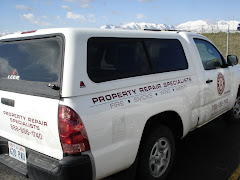
With winter right around the corner, there are several things that as homeowners you need to be aware of. In our line of work we see flood after flood, especially during the springtime. Most of these can be prevented in the fall by doing a few simple things around the house and yard.
Start by turning off your outside water and detaching your hose, this allows the excess water to drain out the pipe. If not, water gets trapped in the exterior water faucet where the hose connects and slides back into the pipe. When the water freezes, the pipe expands causing it to crack. The pipe is underground and is not visible. When you turn on your water on in the spring, the water escapes out the cracked in the pipe, and only has one place to go, your basement!
If you have a sump pump, make sure it is draining properly by pouring water into the sump tank, watch to make sure the float rises and is able to trigger the pump. If the pump is working properly the water should drain quickly and lower the float to shut off the pump. If float does not trigger the pump check the float, it may be catching on something, reposition the pump and try again. If this does not work you’ll most likely need to replace the float. If the water starts to lower and the pump doesn’t shut off, this also indicates you need a new float.
Drain your swamp cooler completely and clean out the bottom tray. Remove the buildup of mineral deposits so that it doesn’t freeze and become impossible to remove in the spring. It is vital to disconnect the water line from both the unit and supply. Blow out all the excess water to prevent freezing. Cover the unit to protect from snow.
Clean out your gutters and storm drains. As the snow starts melting, keep a clear path for the water to go. Your down spouts should be pointed to a well draining area to carry the water away from your home. Downspouts should not be positioned near window wells or hills. If your gutters are full of dirt and leaves, the melting snow and rain can back up and can form an ice dam if freezing occurs. Ice dams are formed on slanted roofs. Poor insulation causes heat to escape from the house, melting snow on the roof. The resultant water travels down to the overhang where it refreezes above the eave of the roof, and where there is also a lack of heat. The formed ice creates a frozen buildup or dam. Water cannot escape past this ice blockage, and therefore accumulates on the roof, eventually making its way beneath the shingles and may leak through into the house.
Have your furnace and ducts inspected and cleaned before turning your furnace on. Check all of your smoke and carbon monoxide detectors to make sure they are working properly. Have your chimney flue cleaned and make sure the damper is opening and closing properly. If you use a gas fireplace have that inspected as well. Have a fire extinguisher on hand in your home, if you have one and it’s older than ten years, it should be replaced.
If you need any help or have questions call Advanced Restoration 888.886.1740






